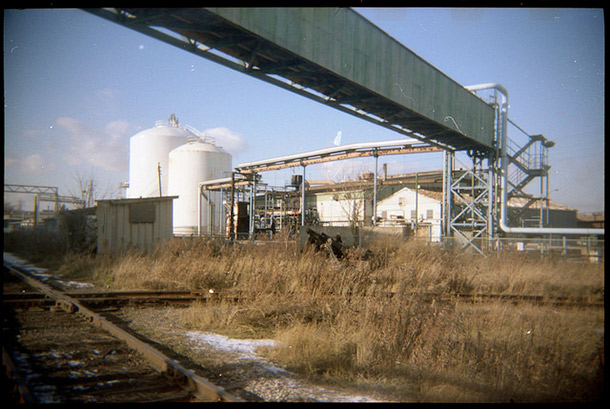The drop in oil prices, coupled with a low dollar, should have provided the ideal opportunity for Canada's manufacturers to ramp up their factories. But it may be a while before the sector is humming again because many operations have closed or shuttered in the last decade, economists say.
As a result, these manufacturers -- with their infrastructures gutted -- aren't in a position to take advantage of a surging U.S. economy and a weak loonie.
Usually a lower Canadian dollar means that manufacturing benefits, with companies opening shop -- mainly in southwestern Ontario -- to take advantage of lower production costs than those in the United States, where most of our exports are shipped.
But Mike Moffatt from the Mowat Centre -- an Ontario public policy think-tank -- told The Tyee the manufacturing sector is not in a position to capitalize on the weaker dollar because many factories have been shuttered for the last decade.
"A lot of these plants are now closed and mothballed," Moffatt said. "They don't have a lot of idle resources sitting around that they can use to quickly ramp-up their production."
Moffatt points to the Ford factory in Talbotville, Ont., south of London. It employed about 2,000 people and closed in 2011. Moffatt said he doubted it will start up again.
"A lot of that equipment's gone or in disrepair, it's simply not there," he said. "Those companies have either gone out of business or moved on to places like the southeast U.S. or Mexico."
He said many companies aren't willing to take the risk to move back to Canada for what could be a short-lived low dollar if oil prices do rise once again.
That's because in the late 1990s, when the dollar was as low as 65 cents U.S., many Canadian companies expanded, hiring and investing rapidly only to be wiped out when the Canadian dollar began to climb, he said.
"Memories are long," Moffatt said. "Companies are not going to do that again."
TD Bank Group economist Brian DePratto said exports have been declining since June 2014 when Canada's exports peaked at $45 billion.
Oil exports decline
The drop in oil prices saw oil exports decline by $3.8 billion, while manufacturing increased $1.4 billion.
That leaves a gap of $2.4 billion in Canada's export market. But unlike Mowatt, DePratto doesn't count out the manufacturing sector being able to make up the difference.
He said the low dollar might be able to provide a base for manufacturers to grow, although this has not yet occurred.
"The stage has been set, but it remains to be seen whether or not we will see that large resurgence in the manufacture exports," DePratto said. "Today the growth has been modest."
Statistics Canada figures show that in January Canada widened its overall trade deficit with its trading partners, except the U.S.
That means the U.S. is the only country to which Canada is exporting more goods than it is importing.
Between December 2014 and January, the trade deficit widened from $3.4 billion to $3.7 billion, making it the biggest trade deficit since 2012.
Some economists argue short-term trade deficits aren't necessarily bad, but over time they can cause inflation by lowering the Canadian dollar further, making it more expensive to import goods.
Last week in the House of Commons, Liberal trade critic and former business journalist Chrystia Freeland demanded that the Conservative government take action to narrow that deficit.
Later, in an interview, Freeland said she too believes the "hollowing out" of the Canadian manufacturing sector during the last decade is affecting the ability of Canada's manufacturers to capitalize on the low dollar.
"When you lose ground in a market, it's very hard to just bounce back," Freeland said. "I'm afraid that is something that is going on in our manufacturing sector."
Freeland said the situation underscores the need for a balanced export strategy, taking into account both manufacturing and commodities from the Canadian government. She added that the country needs "an economy that fires on more than one engine."
She said Canada must nurture manufacturing sectors that are already strong, but also look toward the future and start investing in high-tech skills training and innovation.
"We are increasingly moving towards an advanced manufacturing economy," Freeland said. "What we also really want to double down on is research and development, invest in engineering talent."
Moffatt said he is also optimistic about the prospect of Canada's manufacturing sector switching to one based more on high-tech, quality goods, though he stressed it's not going to happen overnight.
He said the kind of manufacturing operations that are doing well in Ontario now and will continue to grow in the future use a lot of automation, and therefore generate wealth but not blue collar jobs.
"There's going to be a fair number of people working in these companies, but they're going to be things like research and development engineers and sales people and marketing people," he said. "The kind of jobs that require a diploma or degree."
He urged Canada not to aim for a model dependent on poorly-paid, low-skilled labour, such as what has happened in parts of the U.S., Moffatt said.
"That's a kind of race to the bottom that you can't really win and you don't want to win." ![]()
Read more: Labour + Industry















Tyee Commenting Guidelines
Comments that violate guidelines risk being deleted, and violations may result in a temporary or permanent user ban. Maintain the spirit of good conversation to stay in the discussion.
*Please note The Tyee is not a forum for spreading misinformation about COVID-19, denying its existence or minimizing its risk to public health.
Do:
Do not: